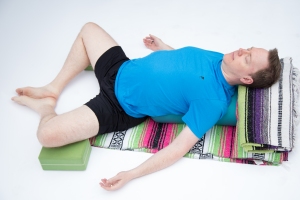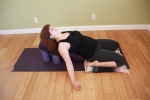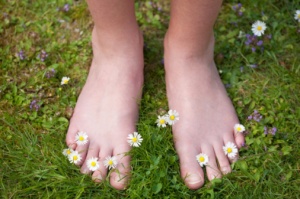One of the things I love most about Yin Yoga is its connection to the elements of nature. This comes from the special influence of Chinese Medicine upon Yin Yoga, and it helps practitioners bring nature, the environment, natural forces, and seasonal cycles into our practice.
In Chinese Medicine, energy is deliberately stimulated along the meridian lines that run throughout the body. In Yin Yoga, the theory is that we stretch the body along these same meridian lines, which produces something like a self-acupressure effect. Each of the main organ meridian pairs is connected with one of the 5 Elements: Water, Wood, Fire, Earth, and Metal. In turn, each of the 5 Elements relates to one of the 5 Seasons…yes, 5 seasons!
In this system, the Earth Element has its own season outside of the four we traditionally recognize in Western culture. The  Late Summer/Early Fall transition is the time of Earth Element, which coincides with the peak of the harvest. You can recognize attributes of Earth Element in your environment at any time, but we bring them into greater focus during this short season of the year. These qualities include hardness and solidity; Earth Element gives structure and support. In traditional Buddhist meditations on the Elements, one would contemplate the hardness of the bones, the structure of the skeleton, the mineral quality of the teeth, etc. to experience the Earth aspects of the human body – the same Earth qualities we observe in mountains, rocks, and geological structures that shape the planet itself.
Late Summer/Early Fall transition is the time of Earth Element, which coincides with the peak of the harvest. You can recognize attributes of Earth Element in your environment at any time, but we bring them into greater focus during this short season of the year. These qualities include hardness and solidity; Earth Element gives structure and support. In traditional Buddhist meditations on the Elements, one would contemplate the hardness of the bones, the structure of the skeleton, the mineral quality of the teeth, etc. to experience the Earth aspects of the human body – the same Earth qualities we observe in mountains, rocks, and geological structures that shape the planet itself.
In nature, the Earth Season is a time of abundance. For us, it is a signal to slow down and take in the fruits of our labors – the results of our efforts in Spring and Summer. If you’ve read earlier posts about Spring/Wood Element and Summer/Fire Element, you know that these times of year are actively involved with initiating change and bringing plans to fruition (analogous to planting seeds and growing crops). Grounded in the strong foundation of that work, we now enjoy greater equanimity and begin to sense more self-acceptance, integration, gratitude, and contentment as we arrive at the harvest.
 The organ meridians involved with Earth Season are the Spleen (Yin) and Stomach (Yang) Meridian pair, which are related to digestion and both the physical and emotional sense of satisfaction and “enoughness.” The Spleen is also part of the immune system, and along with the Stomach, it affects how we accept or reject food and germs, as well as how we process information and emotional energy from others.
The organ meridians involved with Earth Season are the Spleen (Yin) and Stomach (Yang) Meridian pair, which are related to digestion and both the physical and emotional sense of satisfaction and “enoughness.” The Spleen is also part of the immune system, and along with the Stomach, it affects how we accept or reject food and germs, as well as how we process information and emotional energy from others.
 In your Yin Yoga and meditation practice, you can highlight Earth Element in a variety of ways. The solidity and stability of props like blocks, bolsters, and blankets can be seen as an expression of Earth Element – the weight of sandbags can be especially grounding. In your Yin (and Yang) sessions, you can choose poses that affect the Spleen/Stomach Meridians (quadriceps, inner leg, abdomen), such as Cat Tail Pose shown above or Half Knee to Chest on a Block shown on the right, with a sandbag on the extended thigh (if appropriate for you). Grounding through the feet and legs in your standing poses, or massaging the feet can also be great ways to heighten the connection to the Earth they stand on.
In your Yin Yoga and meditation practice, you can highlight Earth Element in a variety of ways. The solidity and stability of props like blocks, bolsters, and blankets can be seen as an expression of Earth Element – the weight of sandbags can be especially grounding. In your Yin (and Yang) sessions, you can choose poses that affect the Spleen/Stomach Meridians (quadriceps, inner leg, abdomen), such as Cat Tail Pose shown above or Half Knee to Chest on a Block shown on the right, with a sandbag on the extended thigh (if appropriate for you). Grounding through the feet and legs in your standing poses, or massaging the feet can also be great ways to heighten the connection to the Earth they stand on.
I particularly like Standing Meditation and Walking Meditation for emphasizing Earth Element. As you stand (as in Mountain Pose), or move in slow walk, you can sense into your bony structure to feel Earth Element manifested in your own form. You can also soak in the calming, grounding effects of your feet touching the Earth. Check this earlier post on Earth Element for further instructions on Walking Meditation. Enjoy!

 The Small Intestine Meridian – perhaps surprisingly – is also located in the upper body, running through the neck, upper back/shoulders, and down the back of the arm.
The Small Intestine Meridian – perhaps surprisingly – is also located in the upper body, running through the neck, upper back/shoulders, and down the back of the arm.











